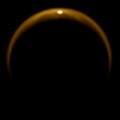Файл:PIA12481 Titan specular reflection.jpg
Перейти к навигации
Перейти к поиску

Размер этого предпросмотра: 600 × 600 пкс. Другие разрешения: 240 × 240 пкс | 480 × 480 пкс | 768 × 768 пкс.
Исходный файл (768 × 768 пкс, размер файла: 35 Кб, MIME-тип: image/jpeg)
История файла
Нажмите на дату/время, чтобы посмотреть файл, который был загружен в тот момент.
| Дата/время | Миниатюра | Размеры | Участник | Примечание | |
|---|---|---|---|---|---|
| текущий | 15:29, 12 декабря 2018 |  | 768 × 768 (35 Кб) | Kesäperuna | 100% JPEG quality from full quality TIFF. |
| 07:16, 18 декабря 2009 |  | 768 × 768 (14 Кб) | WolfmanSF | {{Information |Description={{en|1=This image shows the first flash of sunlight reflected off a lake on Saturn's moon Titan. The glint off a mirror-like surface is known as a specular reflection. This kind of glint was detected by the visual and infrared m |
Использование файла
Следующие 2 страницы используют этот файл:
Глобальное использование файла
Данный файл используется в следующих вики:
- Использование в an.wikipedia.org
- Использование в ar.wikipedia.org
- Использование в be.wikipedia.org
- Использование в ca.wikipedia.org
- Использование в cs.wikipedia.org
- Использование в en.wikipedia.org
- Использование в en.wikinews.org
- Использование в en.wikiversity.org
- Solar System, technical/Titan
- Draft:Original research/Titan
- Astronomy college course/Miranda and Titan
- Astronomy college course/Miranda and Titan/questions
- OpenStax Astronomy/Test 3 Study guide
- Astronomy college course/Unit 3 study guide
- Wright State University Lake Campus/2016-1/Phy1060/T3 upgrade
- Wright State University Lake Campus/2017-1/Phy1060/printPDF
- Wright State University Lake Campus/2019-1/Phy1060/Old studyguide/Pdf
- Quizbank/All questions
- Использование в fr.wikipedia.org
- Использование в gl.wikipedia.org
- Использование в hy.wikipedia.org
- Использование в id.wikipedia.org
- Использование в it.wikipedia.org
- Использование в ja.wikipedia.org
- Использование в ka.wikipedia.org
- Использование в mk.wikipedia.org
- Использование в mwl.wikipedia.org
- Использование в no.wikipedia.org
- Использование в pl.wikipedia.org
- Использование в pt.wikipedia.org
- Использование в ro.wikipedia.org
- Использование в ta.wikipedia.org
- Использование в ta.wikinews.org
- Использование в uk.wikipedia.org
- Использование в vi.wikipedia.org
- Использование в xmf.wikipedia.org
- Использование в zh.wikipedia.org
Просмотреть глобальное использование этого файла.

